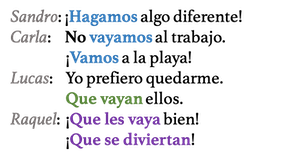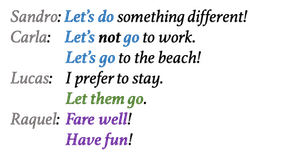53. Exhortaciones: vamos, que vaya él, que te vaya bien
( \newcommand{\kernel}{\mathrm{null}\,}\)
 |
 |
 |
| El siguiente conjunto de expresiones emplean formas del presente simple del subjuntivo como un imperativo indirecto para exhortar a un grupo que incluye a quien habla (no vayamos), indicar lo que otra persona debe hacer (que vayan ellos) y expresar deseos (que te vaya bien). | The following set of expressions also use Simple Present Subjunctive forms as indirect commands to encourage a group in which the speaker is included (let's not go), indicate what someone else should do (let them do it), and express wishes (may it go well for you). |
¡Hagamos algo!
| Es común exhortar a dos o más personas a través de expresiones con la primera persona del plural (nosotros): Hablemos. Comencemos. Hagamos otra cosa. Sigamos en contacto. No juzquemos sin la información necesaria. |
It is common to encourage two or more people using expressions in the first person plural (nosotros), equivalent to English "Let us..." Let's talk. Let's begin. Let's do something else. Let's stay in touch. Let's not judge without the necessary information. |
| • Para exhortaciones afirmativas con el verbo ir se prefiere el presente simple de indicativo: Vamos. Vámonos de aquí. PERO: No vayamos al trabajo hoy. Vamos también se emplea como interjección para exhortar o exclamar: Vamos, debemos salir ahora mismo. ¡Vamos, qué absurdo! |
• For affirmative exhortations with ir, the Simple Present Indicative form is preferred: Let's go. Let's get out of here. BUT: Let's not go to work today. Vamos is also used as an interjection for exhortations or exclamations: Come on, we must leave right now. Come on, how absurd! |
| • Siguiendo el patrón del imperativo, los pronombres reflexivos y de complemento se unen al final de las formas afirmativas, lo que requiere añadir la tilde según las reglas generales (ver §04): Limpiemos la casa vs. Limpiémosla Escribamos (a Juan) vs. Escribámosle PERO: No la limpiemos. No le escribamos. Cuando se usan se o nos en afmirmaciones, la -s final desaparece: Vamos vs. Vámonos (No nos vayamos) Cuidemos la ciudad vs. Cuidémonos. Sentémonos. (No nos sentemos) Regalémosle el libro a Ana → regalémoselo. |
• Following the pattern for commands, reflexive and object pronouns are attached to the end of the affirmative command forms, addinga written accent according to the general rules (se §04). Let's clean the house vs. Let's clean it Let's write (to Juan) vs. Let's write to him BUT: Let's not write to him/her. When se or nos are used in the affirmative, the verb drops the final -s: Let's go vs. Let's leave Let's take care of the city vs. Let's take care of ourselves Let's sit down. (Let's not sit down) Let's give the book to Ana → let's give it to her. |
¡A practicar!
Fernando siempre quiere hacer las cosas en grupo. Escriba sus respuestas como en el modelo. [Ejercicio interactivo]
Modelo: Piénsalo bien. → No, pensémoslo los dos juntos. (Diccionario)
| 1. Saca la basura. → No, ___________ los dos juntos. 2. Haz el ejercicio. → No, ___________ juntos. 3. Pon la mesa para comer. → No, ___________ los dos. 4. Sal a comprar sal. → No, ___________ los dos juntos. |
5. Duérmete. → No, ___________ juntos. 6. Limpia la casa. → No, ___________ todos juntos. 7. Relájate. → No, ___________ los dos. 8. Descansa. → No, ___________ juntos. |
- Respuestas
- 1) saquémosla 2) hagámoslo 3) pongámosla 4) salgamos 5) durmámonos 6) limpiémosla 7) relajémonos 8) descansemos
Que me llame ella
| Para indicar que no queremos hacer algo porque otra persona debe hacerlo, se emplea que + la tercera persona del verbo en presente del subjuntivo: Que vayan ellos. Que se vaya Miguel. Que lo haga tu familia. Que lo decidan los expertos. Que espere. |
In order to indicate that you do not want to do something but rather let someone else do it, use que + the third person present subjunctive form: Let them go. Let Miguel leave. Let your family do it. Let the experts decide. Let him/her wait. |
| Esta misma estructura se emplea en la expresión: ¡Que viva...!, a menudo prescindiendo del "que": ¡Que viva la reina! ¡Que vivan los novios! ¡Vivan nuestros músicos! ¡Viva la gente! |
This same structure is used in the expression: ¡Que viva...!, which often drops the initial que: Long live the Queen! Hail to the bride and groom! Long live our musicians! Up with (long live) the people! |
¡A practicar!
Fernanda nunca quiere hacer las cosas ella misma. Escriba sus respuestas como en el modelo. [Ejercicio interactivo]
Modelo: Saca la basura. → No, que la saquen ellos. (Diccionario)
| 1. Ve a la farmacia. → No, ___________ ellos. 2. Haz la tarea. → No, ___________ mis compañeros. 3. Pon la mesa para comer. → No, ___________ Miguel. 4. Limpia la casa. → No, ___________ mi hermano. |
5. Comunícate con tus padres. → No, ___________ ellos conmigo. 6. Sigue mis consejos. → No, ___________ otros; yo, no. 7. Abre la ventana. → No, ___________ Julio. 8. Lava los platos. → No, ___________ otra persona. |
- Respuestas
- 1) que vayan 2) que la hagan 3) que la ponga 4) que la limpie 5) que se comuniquen 6) que los sigan 7) que la abra 8) que los lave
¡Que disfrutes!
| Para expresar deseos hacia otros, es común usar que + la segunda persona del verbo en presente del subjuntivo (tú, vos, usted, ustedes, vosotros): ¡Que se diviertan! (ustedes) • ¡Que os divirtáis! (vosotros) ¡Que disfrutes la película! (tú) • ¡Que disfrutés la película! (vos) ¡Que se mejore pronto! (usted) ¡Que seas feliz! (tú) Hay también una frase frecuente con el verbo en tercera persona del singular: ¡Que te vaya bien! (a ti, a vos) ¡Que le vaya bien! (a usted) ¡Que les vaya bien! (a ustedes) ¡Que os vaya bien! (a vosotros) |
To express wishes toward others, it is common to use que + the second person present subjunctive form (tú, vos, usted, ustedes, vosotros): Have fun! (you all) Enjoy the movie! Get better soon! May you be happy! And there is this widely used expression with the verb in the third person singular. May it go well! (may you do well, good luck, fare well) |
¡A practicar!
Escriba en el paréntesis el número de la oración de la izquierda que corresponde a cada deseo de la derecha.
[Ejercicio interactivo] (Diccionario).
| 1. Ya nos vamos. 2. Voy a un concierto. 3. Vamos a pasar el día en la playa. 4. Tengo un examen de matemáticas. 5. Tengo un poco de fiebre. 6. Voy a dormirme ahora. 7. Vamos a un restaurante. |
( ) ¡Que coman rico! ( ) ¡Que te mejores pronto! ( 1 ) ¡Que les vaya bien! ( ) ¡Que duermas bien! ( ) ¡Que se diviertan en el mar! ( ) ¡Que disfrutes la música! ( ) ¡Que te vaya bien con los números! |
- Respuestas
- 7 - 5 - 1 - 6 - 3 - 2 - 4


